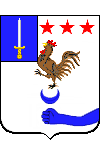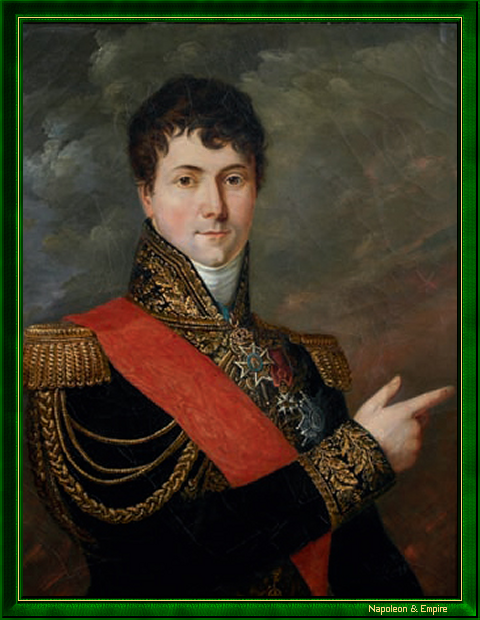César Charles Étienne Gudin de la Sablonnière
Count of the Empire
Pronunciation:

César Charles Étienne Gudin de la Sablonnière, more commonly known as Charles Étienne Gudin, was born in Montargis, Orléanais [now Loiret] on February 13, 1768, into a noble family with a strong military tradition. He was the son of Gabriel Louis Gudin (1732-1819), a former officer and controller of aid to the department (today we would say tax controller),, and Marie Anne Humery de la Boissière (1736-1827). César's uncle Étienne became a general during the Revolution.
At the age of eleven, young Gudin entered the Brienne military academy , the same year as a certain Napoleon Bonaparte, a year his junior. He left the school in 1782, however, to join the king's guard as a supernumerary gendarme. In 1784, the Artois-Infanterie regiment welcomed him as a replacement second lieutenant, then as a full second lieutenant on June 14, 1786. He was still with the regiment at the time of the French Revolution, and was promoted to lieutenant on January 1, 1791. On January 28 of that year, the newly promoted lieutenant left for Saint-Domingue as part of the expedition to quell the slave uprising there.
On his return, on July 5, 1792, Gudin joined the Army of the Rhine in Strasbourg. His uncle, a major general, employed him as aide-de-camp from May 1793. Gudin's career then took him through the Army of the North and then the Army of the Ardennes, where he was appointed provisional adjutant general and battalion commander on December 26, 1793. He returned to the Armée du Nord a little later, before joining the Armée de Rhin-et-Moselle as adjutant general and brigade commander on June 13, 1795. On July 14, 1796, he captured the Black Forest town of Wolfach. General Laurent de Gouvion Saint-Cyr then took him on as chief of staff, a position he temporarily relinquished in November to fulfill the same duties, this time within the garrison of Kehl, a German town near Strasbourg. On February 5, 1799, Gudin was promoted to brigadier general in the army of observation stationed under Mannheim.
He served in this rank under illustrious superiors: Joseph Souham in the Danube army, Jean-de-Dieu Soult and Claude Jacques Lecourbe in the Helvetian army. It was under the latter that he captured the Grimsel Pass on August 14, 1799, before joining his commander for the battle of Oberalp. At the end of September, when Generalfeldmarschall Alexander Vasilyevich Suvorov chased him out of Airolo and the Gotthard, he crossed the Furka and Grimsel passes, returned via the Reuss valley and retook the Gotthard and Oberalp. In October, Lecourbe, who had been transferred to command the Army of the Rhine, called Gudin back to him as chief of staff. Gudin took part in the battle of Philipsbourg, followed by those of Stein, Stokach, Moesskirch and Menningen. On May 23, 1800, he led a division for the first time, temporarily replacing Dominique-Joseph-René Vandamme.
He then served in Bavaria: at the crossing of the Lech, at Hochstaedt, at Neuburg [Neuburg an der Donau] in June 1800, then took charge of one of the divisions of Lecourbe's army on July 4. On the 11th, he took control of Fuessen. In December, he took part in the crossing of the Inn and the battle of Salzburg. In the meantime, a consular decree of August 22, 1800 confirmed his rank, which had been established on July 6.
After the end of the war (Peace of Lunéville), Gudin returned to Paris, where the First Consul Napoleon Bonaparte received him and congratulated him on his conduct, but did not entrust him with a command until August 1803.
On that date, Gudin became head of the tenth military division in Toulouse. Barely a year later, however, Emperor Napoleon I gave him a more active post. On August 23, 1804, Gudin took command of the 3rd infantry division at the Bruges camp, under Marshal Louis-Nicolas Davout. The following months were devoted entirely to intensive training of the troops, based on non-stop firing exercises and maneuvers.
On August 29, 1805, the Grande Armée was born. On the 30th, Davout's men became the 3rd corps and set off for Vienna [Wien]. Gudin's division comprised three brigades, representing eight battalions and almost 7,000 soldiers. Stationed at Presburg [now Bratislava], it did not arrive at the site of the battle of Austerlitz until December 3, the day after the confrontation.
Gudin's consolation came on October 14, 1806, at the battle of Auerstaedt, where his division was the first to come into contact with the enemy, containing it for over an hour and a half, despite overwhelming numerical inferiority and the efforts - which we can only imagine were frenetic - of Gebhard Leberecht von Blücher's cavalry. The arrival of his colleagues Louis Friant (1st division) and Charles Antoine Morand (2nd division) gave the 3rd corps a resounding victory. Their trio, dubbed "le brelan" by Napoleon, was considered one of the greatest assets of the corps and the army as a whole. Of the three, however, it was Gudin who played the leading role in the battle of Auerstaedt. His division suffered a frightening total of over 3,500 casualties. Justly rewarded, Gudin and his soldiers led the way for the 3rd Corps when it entered Berlin at the head of the French army.
As the campaign continued in Poland, Gudin captured the town of Custrin [Kostrzyn nad Odrą] on November 1st and reached Warsaw [Warszawa] on the 29th. In December, he fights at Pułtusk (unless, ill, he has been replaced there by General Joseph Daultanne). On February 8, 1807, at the battle of Preußisch Eylau [now Bagrationovsk], with his two companions Morand and Friant, he again played an important role in the success laboriously wrested from the Russians.
His eminent services naturally earned him the title of Count of the Empire in June 1808. He was also appointed Governor of the Château de Fontainebleau in 1809, before returning to Austria for the 1809 campaign.
During this campaign, Gudin played a role in almost every major engagement: on April 20, 1809, at Abensberg, where he was temporarily under the command of Marshal Jean Lannes; on April 22 at Eckmühl, where "le brelan" once again proved such a marvel that its leader soon bore the name of this battle; the following day at the capture of Regensburg. Although he was unable to take part in the battle of Aspern-Essling on May 21 and 22 - the breaking of the bridge over the Danube condemned him to be a mere spectator, like the entire 3rd corps, blocked on the right bank while the fighting raged on the left - on the following July 6, on the second day of the battle of Wagram, he picked up no fewer than four wounds. His performance throughout the campaign earned him the rank of Grand Eagle of the Légion d'Honneur. Once the Schoenbrunn Peace Treaty had been signed, he was stationed in Westphalia, then in Magdeburg.
During the French Invasion of Russia of 1812, Davout's corps changed number to 1st Corps, but Gudin remained commander of his 3rd division, except during the first weeks when the Morand, Friant and Gudin divisions were placed under the Emperor's direct orders. After contributing effectively to the capture of Smolensk on August 17 and 18, Gudin was mortally wounded on the 19th during the battle of Valoutina-Gora . Sent to reinforce a struggling Michel Ney, he advised him to wait before attacking, until the end of the movement undertaken by Jean-Andoche Junot. Gudin's reply: You'll see how my division knows how to take a position it has been assigned to attack.
Just as he was about to succeed in dislodging the enemy, a cannonball tore off his left thigh and right calf. Transported to Smolensk, Gudin died of his wounds three days later (only two, according to some sources), after a visit from Napoleon.
He was buried in one of the citadel's bastions. The Emperor praised him in the 14th Bulletin de la Grande Armée and, in a rare tribute, wrote a letter of condolence to his widow, Marie Jeannette Caroline Christine Creutzer, in which he promised to look after her five orphans. Marshal Davout, unsuspecting of sentimentality, wept at the news of the death of his subordinate and friend.
"General Charles Étienne Gudin de la Sablonnière" by Georges Rouget (Paris 1783 - Paris 1869).

Gudin was an offensive general, often placed in the vanguard of Davout's corps. But he was also attentive to the lives of his men, whom he knew how to spare. Strict on discipline, like his commander, he demanded that his troops have a thorough knowledge of the rules and regulations, and that they carry out their exercises to the letter. This rigor was combined with a high regard for his soldiers, which helped him to get the best out of them.
His body was found during excavations in Smolensk in 2019. A comparison between the DNA of one of Gudin's descendants and that of a skeleton with wounds similar to those described for the general enabled him to be identified with certainty. His ashes were transferred to the crypt of the Église du Dôme at Les Invalides on December 2, 2021. His heart, on the other hand, already rested in a chapel in the Père-Lachaise cemetery (40th division) in Paris.
General Gudin's name is inscribed on the eastern side of the Arc de Triomphe de l'Étoile .
A plaque is affixed to his birthplace, 7 rue du Général Gudin in Montargis.
His brother, Pierre César Gudin des Bardelières, was also an Empire general.